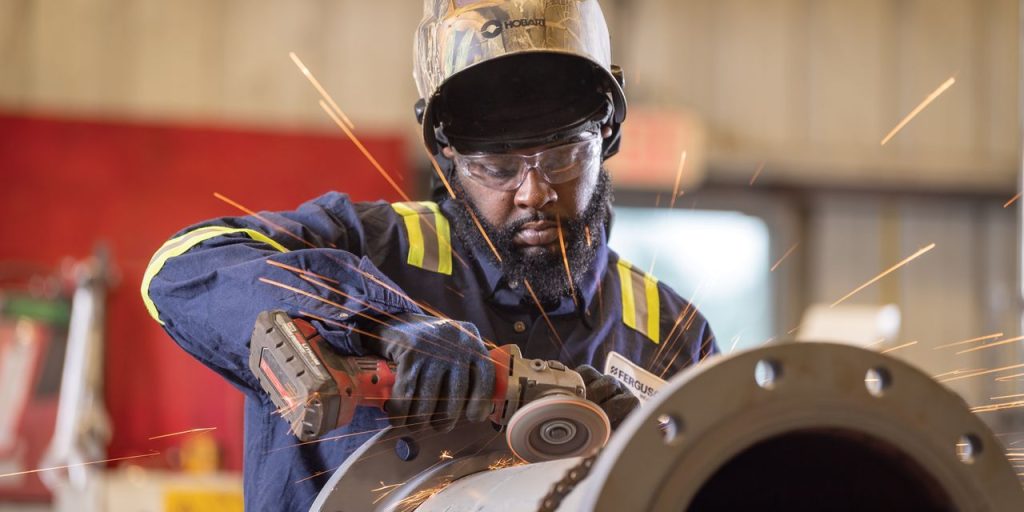Sometimes, boring businesses make exciting investments. In the case of
Ferguson,
a wholesale distributor of plumbing, heating, ventilation, and air-conditioning products, boring could prove exciting enough to put it in the
S&P 500.
Ferguson (ticker: FERG) is the largest plumbing and HVAC distributor in the U.S. Its customers are mainly contractors and maintenance professionals. But it also sells to do-it-yourselfers, chiefly through its build.com website.
Plumbing might not capture hearts and minds, but it is necessary—and that’s a good thing in this economy, with rising interest rates stirring concerns of a potential slowdown. Not only does Ferguson’s valuation look downright cheap, some catalysts could boost the shares.
The United Kingdom-based company, one of the largest distributors of any kind in North America, generated $29 billion in sales in calendar year 2022 and about $2.9 billion in operating profit. American investors might not realize that.
In the past, “we were very disparate,” says CEO Kevin Murphy. At one time, Ferguson operated in 28 countries across Western Europe and North America. Murphy has been changing that. The company, formerly called Wolseley, completed the sale of its European businesses in early 2021. Then in 2022, Ferguson, which is managed from Newport News, Va., moved its primary stock market listing to the New York Stock Exchange.
It now focuses solely on North America. In the U.S., it has 1,500 branches, 10 distribution centers, and 33,000 employees. In Canada—where it operates mainly under the Wolseley brand—it has 211 branches, one national distribution center, and some 3,000 workers.
Ferguson stock isn’t a household name. “This one has discovery potential,” says Baird analyst Dave Manthey. More than 20 analysts now cover the company, but only a handful are based in the States. The company is seeking to change that. Without local coverage, American portfolio managers aren’t likely to look closely at the stock.
Given its size and status as one of the continent’s biggest distributors, Manthey thinks it could be added to the S&P 500, which would make it a mandatory holding for many index funds. Funds with almost $16 trillion in assets track the large-capitalization index, says S&P Global. None of that money looks at Ferguson right now.
“We do a heck of a lot to build America,” says Murphy. “So we think we’d be a good candidate” for inclusion in the index.
Ultimately, earnings and cash flow determine a stock’s worth. In its latest fiscal year’s first half, ended Jan. 31, reported sales were $14.76 billion, versus $13.3 billion a year earlier. Fully diluted earnings were $4.64 a share, up from $4.38.
Ferguson trades for less than 14 times estimated calendar year 2023 earnings, versus 20 and 22 times, respectively, for industrial products distributor
W.W. Grainger
(GWW) and HVAC distributor
Watsco
(WSO). Ferguson is cheaper, though its profits have climbed at a rate close to theirs. Growth at all three looks attractive. The distribution industry is relatively fragmented, which allows companies within it to expand faster than the overall economy by picking up market share from smaller players and adding sales through bolt-on acquisitions.
Murphy believes that the North American plumbing, HVAC, and related markets amount to about $340 billion a year, which currently gives his company about a 9% market share.
Ferguson’s sales and operating profits have grown at average annual rates of 7% and 14%, respectively, over the past five years. Grainger’s growth rates were 8% and 14% over the same span, while Watsco’s were 11% and 19%.
Looking ahead, Wall Street expects Grainger to expand sales and earnings at about 8% and 9% annually over the next couple of years. The comparable numbers for Watsco are 4% and 1%. Ferguson falls in the middle: Its yearly sales and operating profit are expected to rise by 2% and 6%.
At a valuation multiple between those two stocks—about 21 times estimated calendar year 2023 per-share earnings of $9.34—Ferguson shares would trade at almost $200, well above their recent quote around $126.
That might seem excessive for a stock growing profits at just 6% a year, but the earnings estimates look low. The company typically adds two to three percentage points of top-line growth annually via acquisitions, says Manthey. That hasn’t been factored into the numbers yet, he says.
Manthey, who began coverage in December 2021, rates Ferguson Outperform, with a $160 price target. He sees a $200 stock down the road, as investors gain more exposure to the big distributor and the economy improves. In fact, Ferguson shares are his top pick for 2023.
J.P. Morgan analyst Patrick Baumann began covering Ferguson in March with an Overweight rating and $150 price target. He writes that near-term results might be choppy, but that “we have a positive view on the company and management team, and see relative valuation as reasonable.”
The possible choppiness reflects Ferguson’s exposure to the construction markets—both residential and nonresidential—which are slowing as interest rates rise. Still, about 60% of Ferguson’s business comes from a less volatile area, what the company calls RMI, for repair, maintenance, and improvement. And almost 10% comes from municipalities and isn’t tied as closely to the economic cycle.
Ferguson’s cheap valuation should more than compensate for near-term construction-related risks. Longer term, its solid fundamentals could pay off nicely for investors, especially if it does move into the S&P 500.
Who said that leaky faucets and malfunctioning air conditioners can’t be exciting?
Write to Al Root at [email protected]
Read the full article here
















